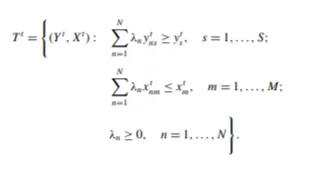Production Technology and Efficiency in Education Sector
- 06 Pages
- Published On: 10-11-2023
Production technology and output-oriented efficiency measurement
The output-oriented efficiency measurement was adopted by Günay & Dulupçu (2019) in their research to measure the efficiency output in the education sector using technology. As such, the researcher introduced a production technology time t where N represented the decision-making unit (DMUs). The unit used a vector Xt = (Xt,.XTM) the m inputs, which were meant to produce the vector Yt = (yt 1,...,yt S ) of the s outputs. The observed outputs and known inputs for the DMUs in the education sector are Xt n = (xt n1,...,xt nM ) and Y t n = (yt n1,...,yt nS ), respectively. Additionally,lly Daraio, (2020) used Y t i ≥ Y t j iff yt is ≥ yt js∀s and yt is > yt js for some s = 1, S. As such, they represented production in the education sector using the following set (PPS)at time t:


Additionally, Arias-Ciro (2020) used technology in his research to try and understand the nondiscretionary inputs in the education sector. As such, they represented the nondiscretionary inputs using the diagram below and the empirical PPS with the existing technology using the equation shown.

The figure represented the Production technology in the education sector

According to Schaefer & Dyckhoff, (2020) research, the Dt (Y t j,Xt j) creates a biassed measure since it includes both efficiency and the effect of the non-discretionary variable on output. The output-oriented measure of efficiency appropriate for a technology with non-discretionary inputs is:

Non- oriented direction distance
The non-oriented direction distance was employed by Gralka et al. (2019) in their research to try and understand the efficiency in the health sector by understanding the output of the efficiency in the sector. In their research, they found out that the non-oriented direction worked very well in the OECD countries because most of the countries had cost containment in the public health sector. As such, Coupet & Berrett (2019) stated in the research that, in some other countries, the bed occupancy rate of 69% is lower than the OECD average of 75%, and they advocate for an increase. This indicates output expansion, because increasing the occupancy rate through input contraction would be equivalent to claiming countries such as Turkey have too many hospital beds. However, that is not the situation in reality. As stated by the OECD, countries such as Turkey have 2.7 acute hospital beds per 1000 inhabitants when non-oriented direction distance is applied. This is significantly lower than the OECD average of 3.8. Additionally, Hoq (2020) states that the non-oriented method was adopted because there was a need to limit "input waste." As such, Coupet & Berrett (2019) adopted the following equation model to understand efficiency in the health sector:

In the equation model adopted by the researchers, "R" 'R' positive outputs, 'K' poor outputs, and I represents the inputs.
Scale Economies and Productivity Growth
The scale economies and productivity growth were adopted by Coomes et al. (2019) to try to analyse the efficiency of the public infrastructure inputs and outputs. As such, Matinheikk et al. (2019) adopted the use of several measures of cost structure to analyse the public sector's efficiency. According to these criteria, the short-run cost elasticity is higher than the long-run cost elasticity. This is consistent with previous findings of Zhang et al. (2018) that inadequate levels of quasi-fixed factors are maintained in the near term of efficacy. As per Crafts & Woltjer (2021), short-run productivity growth indicators suggest a somewhat falling trend. PGQ denotes the rate at which output grows over time while all inputs remain constant. This metric reveals a 1.1% annual reduction in productivity growth. A comparable metric, PGX, calculates the average rate at which all inputs can be lowered while keeping output constant.
Continue your journey with our comprehensive guide to Unlocking England Green Belt.

Reference
- Arias-Ciro, J. (2020). Bibliometric Study of the Efficiency of Public Expenditure on Education. Revista CEA, 6(11).
- Coomes, O. T., Barham, B. L., MacDonald, G. K., Ramankutty, N., & Chavas, J. P. (2019). Leveraging total factor productivity growth for sustainable and resilient farming. Nature Sustainability, 2(1), 22-28.
- Coupet, J., & Berrett, J. L. (2019). Toward a valid approach to nonprofit efficiency measurement. Nonprofit Management and Leadership, 29(3), 299-320.
- Crafts, N., & Woltjer, P. (2021). Growth accounting in economic history: findings, lessons and new directions. Journal of Economic Surveys, 35(3), 670-696.
- Daraio, C. (2020). Nonparametric methods and higher education. In The International Encyclopedia of Higher Education Systems and Institutions (pp. 2109-2114). Dordrecht: Springer Netherlands.
- Gralka, S., Wohlrabe, K., & Bornmann, L. (2019). How to measure research efficiency in higher education? Research grants vs. publication output. Journal of Higher Education Policy and Management, 41(3), 322-341.
- Günay, A., & Dulupçu, M. A. (2019). Measurement of financial efficiency and productivity of Turkish Public Universities by using non-parametric methods. Journal of Applied Research in Higher Education.
- Hoq, M. Z. (2020). E-Learning during the period of pandemic (COVID-19) in the kingdom of Saudi Arabia: an empirical study. American Journal of Educational Research, 8(7), 457-464.
- Matinheikki, J., Aaltonen, K., & Walker, D. (2019). Politics, public servants, and profits: Institutional complexity and temporary hybridization in a public infrastructure alliance project. International Journal of Project Management, 37(2), 298-317.
- Schaefer, J., & Dyckhoff, H. (2020). Performance of efficiency measurement by StoNED compared to DEA and SFA in cases of Leontief and by-production technologies. Available at SSRN 3525708.
- Zhang, L., Zhao, Z., Xin, H., Chai, J., & Wang, G. (2018). Charge pricing model for electric vehicle charging infrastructure public-private partnership projects in China: A system dynamics analysis. Journal of Cleaner Production, 199, 321-333.
- 24/7 Customer Support
- 100% Customer Satisfaction
- No Privacy Violation
- Quick Services
- Subject Experts



